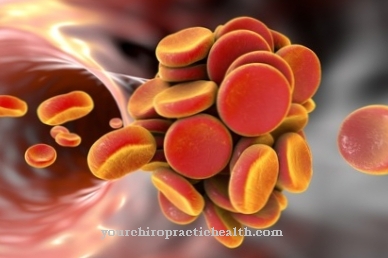A Dopamine agonist or Dopamine antagonist is a drug that can stimulate dopamine receptors. Dopamine agonists are used, among other things, to treat Parkinson's disease, restless legs syndrome or as emetics.
What is a dopamine agonist?

Dopamine agonists, like the neurotransmitter dopamine, can bind to dopamine receptors (D receptors). Depending on the receptor selectivity, the agonists are divided into D1 / 5 and D2 / 3/4 agonists.
By binding to the receptor, the dopamine agonists produce a dopamine-like effect. The selective D1 / 5 agonists such as SKF 81297 or dihydrexin play no role in the treatment of diseases. Agonists that bind to the D2 receptors play a role in the therapy of various diseases.
Well-known D2 receptors are the drugs ropinirole, rotigotine, piribedil or pramipexole. When using dopamine agonists, side effects such as nausea, vomiting, low blood pressure, hallucinations, or confusion can occur.
Pharmacological effect
Dopamine agonists work by stimulating the dopamine receptors like dopamine. Dopamine is a neurotransmitter that belongs to the group of catecholamines. It is made in the human body from the amino acids tyrosine and phenylalanine. The neurotransmitter belongs to the sympathomimetics. These substances strengthen the effect of the sympathetic system. Dopamine increases the blood flow to the abdominal and kidney vessels in a low concentration.
One dopaminergic processing pathway is the mesostriatal system, which has its origin in the substantia nigra in the midbrain. Here, dopamine takes on important tasks in controlling movements. Disorders in this system are one of the causes of the hypokinetic movement disorders in Parkinson's disease.
In the mesolimbic system, a lack of dopamine leads to listlessness. Dopamine antagonists can compensate for a dopamine deficiency and help patients to be more active and enjoy life. If the mesocortical system is underactive, psychoses of the schizophrenic type can develop. In this system too, dopamine agonists become effective by binding to the corresponding receptors.
Dopamine agonists also develop their effect in the tuberoinfundibular system. They inhibit the release of the hormone prolactin on the neurons that run from the arcuate nucleus to the anterior lobe of the pituitary gland. Prolactin is a hormone that is responsible for the secretion of milk (lactation) during breastfeeding.
Medical application & use
One of the main indications for the use of dopamine agonists is Parkinson's disease. Degenerative changes in the extrapyramidal motor system (EPMS) result in a dopamine deficiency. This messes up the neurotransmitter balance. This manifests itself through neurological disorders and especially through disorders of the motor skills.
Typical symptoms of Parkinson's disease are immobility, slowed down voluntary motor skills, increased basic tension in the skeletal muscles and tremors (tremor). In order to slow down the course of the disease and alleviate the clinical symptoms, the patient is usually given dopamine in the form of the precursor L-Dopa. However, the effectiveness of this precursor alone is usually not sufficient, so that the D2 receptors are also simulated with the help of the agonists.
Restless legs syndrome (RLS) is another indication for dopamine agonists. The disorder of the extrapyramidal motor system belongs to the hyperkinesis. The disease manifests itself through twitching, paresthesia and pain in the legs. Similar to Parkinson's disease, restless legs syndrome is treated with a combination of L-dopa and dopamine agonists.
But the dopamine agonists not only play a role in motor skills, they also have an inhibitory effect on prolactin secretion. That is why they are also used for weaning. They are also used to treat hormonal complaints that are associated with an increased production of prolactin. For example, prolactinomas are treated with dopamine agonists such as cabergoline or bromocriptine.
Prolactinomas are hormone-producing tumors of the anterior pituitary gland. The resulting prolactinemia leads to hypoestrogenemia in women with a lack of ovulation and a lack of menstrual bleeding. Breast milk spontaneously escapes from the mammary glands in half of the patients (galactorrhea). Some dopamine agonists are used to treat erectile dysfunction. The term erectile dysfunction describes the absence of an erection of the penis when aroused.
You can find your medication here
➔ Medicines to calm down and strengthen nervesRisks & side effects
Typical side effects of dopamine agonists are nausea, vomiting, and headache. You may experience a drop in blood pressure and fatigue. Some patients experience somnolence or have difficulty sleeping. Restlessness is also often observed.
Other side effects of dopamine agonists are incontinence, edema, hair loss or dizziness. In rare cases, patients develop hallucinations or even psychosis after taking dopamine agonists.
Inhibition of prolactin production is desirable in some patients. However, the effect of dopamine agonists on milk flow must be taken into account during breastfeeding. Otherwise, the milk flow may inadvertently stop.
Dopamine agonists should not be used in organ fibrosis. There is then the risk of connective tissue transformation (fibrosis) of the heart valves. A pleural effusion and high blood pressure are also contraindications. The use of dopamine agonists in hepatic insufficiency is also counterproductive. As a rule, the drugs must not be combined with neuroleptics.












.jpg)



.jpg)










.jpg)
